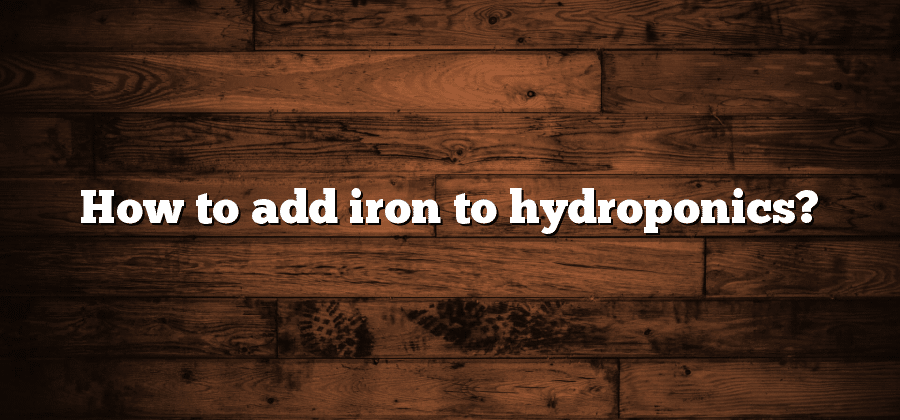Understanding the Importance of Iron in Hydroponics
Iron is an essential micronutrient that plays a critical role in the growth and development of plants in hydroponics. It is a key component of enzymes involved in important metabolic processes, including photosynthesis and respiration. Iron is especially important in hydroponics, as plants rely solely on nutrient solutions for their nutritional needs. As a result, it becomes crucial for hydroponic growers to understand the importance of iron and its impact on the overall health and productivity of their plants.
In hydroponics, iron deficiency can significantly impair plant growth and development. Common symptoms of iron deficiency include yellowing of the leaves, particularly between the veins, and reduced growth rates. These symptoms are primarily attributed to the lack of chlorophyll production, which is iron-dependent. Additionally, plants with iron deficiency may display stunted roots and an overall weakened structure. Thus, it is vital for hydroponic growers to be able to identify these symptoms promptly, as timely intervention can prevent further damage and optimize plant health.
Identifying Iron Deficiency Symptoms in Hydroponic Plants
Iron deficiency is a common problem in hydroponic systems that can significantly impact plant health and growth. Identifying the symptoms of iron deficiency is crucial for timely intervention and ensuring optimal plant performance.
One of the primary signs of iron deficiency in hydroponic plants is chlorosis, which refers to the yellowing of leaves. In the case of iron deficiency, the yellowing usually starts from the newer leaves, while the leaf veins remain green. This is because iron is essential for the production of chlorophyll, the pigment responsible for giving plants their green color. As iron becomes limited, chlorophyll production decreases, leading to the characteristic yellowing of the leaves.
In addition to chlorosis, other visual indicators of iron deficiency include leaf curling and stunted growth. As iron is involved in various metabolic processes within plants, a lack of it can disrupt normal growth patterns. Leaves may also exhibit interveinal necrosis, where the tissue between veins turns brown and dies. This is due to the inability of the plant to transport iron to the affected areas, resulting in cell death.
Selecting the Right Iron Supplement for Hydroponics
In hydroponics, selecting the right iron supplement is crucial for ensuring optimal plant growth and development. Iron plays a vital role in the production of chlorophyll and other essential plant compounds. Without sufficient iron, plants can experience stunted growth, yellowing of leaves, and decreased overall health. Therefore, it is important to choose an iron supplement that meets the specific needs of your hydroponic system.
When selecting an iron supplement for hydroponics, consider the form of iron that is most readily available to plants. Iron can be supplied in various forms, such as iron chelates, iron sulfate, or iron EDTA. Each of these forms has its advantages and disadvantages in terms of solubility and availability to plants. It is advisable to consult with a hydroponics expert or conduct research to determine which form of iron supplement is best suited to your specific crop and growing conditions. Additionally, consider the concentration of iron in the supplement, as too high or too low concentrations can have detrimental effects on plant health.
Preparing the Nutrient Solution for Iron Addition
To ensure optimal growth and health of your hydroponic plants, it is crucial to prepare the nutrient solution for iron addition correctly. Iron is an essential micronutrient that plays a vital role in various physiological processes, including photosynthesis and the production of chlorophyll. Without an adequate supply of iron, plants can suffer from stunted growth and yellowing leaves, leading to decreased yields.
The first step in preparing the nutrient solution for iron addition is to measure the existing iron levels in your reservoir. This can be done using a water test kit specifically designed for hydroponic systems. Once you have determined the current iron concentration, you can calculate the amount of iron supplement needed. It is important to note that iron availability can vary depending on the pH level of the nutrient solution. Therefore, it is crucial to adjust the pH to the optimal range (typically between 5.5 and 6.5) before adding the iron supplement.
Proper Timing and Frequency of Iron Application in Hydroponics
Timing and frequency are crucial factors to consider when applying iron in hydroponics. It is important to understand that iron is best absorbed by plants when the pH level of the nutrient solution is between 5.5 and 6.5. Therefore, it is recommended to monitor the pH levels regularly and make any necessary adjustments before adding iron to the solution.
In terms of frequency, it is generally recommended to apply iron every two weeks in hydroponics systems. However, the frequency may vary depending on the specific needs of your plants and the severity of iron deficiency. Regular monitoring of plant health and visual symptoms of iron deficiency can help determine whether more frequent applications are required. It is important to note that excessive iron application can lead to other nutrient imbalances, so it is crucial to carefully follow the manufacturer’s recommendations and maintain a balanced nutrient solution.






